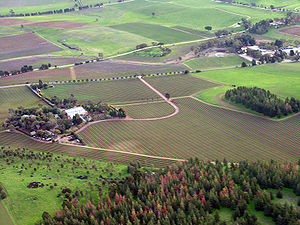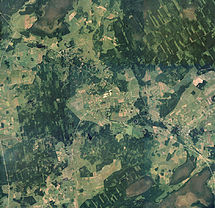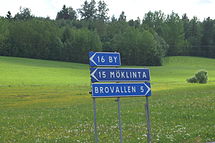- Rural area
-
Rural areas or the country or countryside are areas that are not urbanized, though when large areas are described, country towns and smaller cities will be included. They have a low population density, and typically much of the land is devoted to agriculture. The degree to which areas of wilderness are included in the term varies; very large wilderness areas are not likely to be described by the term in most contexts.
In most parts of the world rural areas have been declining since the 19th century or earlier, both as a proportion of land area, and in terms of the proportion of the population living in them. Urbanization encroaches on rural land, and the mechanization of agriculture has reduced the number of workers needed to work the land, while alternative employment is typically easier to obtain in cities. In parts of the developed world urban sprawl has greatly reduced the areas that can be called rural, and land use planning measures are used to protect the character of rural areas in various ways.
Contents
United States
About 91 percent of the American rural population now earn salaried incomes, often in urban areas. The 10 percent who still produce resources generate 20 percent of the world’s coal, copper, and oil; 10 percent of its wheat, 20 percent of its meat, and 50 percent of its corn. The efficiency of these farms is due in large part to the commercialization of the farming industry, and not single family operations.[1]
84 percent of the United States' inhabitants live in suburban and urban areas,[2] but cities occupy only 10 percent of the country. Rural areas occupy the remaining 90 percent.[1]The U.S. Census Bureau, the USDA's Economic Research Service, and the Office of Management and Budget (OMB) have come together to help define rural areas.;United States Census Bureau:The Census Bureau definitions (new to the 2000 census), which are based on population density, defines rural areas as all territory outside of Census Bureau-defined urbanized areas and urban clusters.:*An urbanized area consists of a central city and surrounding areas whose population ("urban nucleus") is greater than 50,000. They may or may not contain individual cities with 50,000 or more; rather, they must have a core with a population density generally exceeding 1,000 persons per square mile; and may contain adjoining territory with at least 500 persons per square mile (other towns outside of an urbanized area whose population exceeds 2,500).:*Thus, rural areas comprise open country and settlements with fewer than 2,500 residents; areas designated as rural can have population densities as high as 999 per square mile or as low as 1 person per square mile.[3];USDA:* The USDA's Office of Rural Development may define rural by various population thresholds. The 2002 farm bill (P.L. 107-171, Sec. 6020) defined rural and rural area as any area other than (1) a city or town that has a population of greater than 50,000 inhabitants, and (2) the urbanized areas contiguous and adjacent to such a city or town.:* The rural-urban continuum codes, urban influence codes, and rural county typology codes developed by USDA’s Economic Research Service (ERS) allow researchers to break out the standard metropolitan and nonmetropolitan areas into smaller residential groups.[3] For example, a metropolitan county is one that contains an urbanized area, or one that has a twenty-five percent commuter rate to an urbanized area regardless of population.;OMB: Under the Core Based Statistical Areas used by the OMB,::* a metropolitan county, or Metropolitan Statistical Area, consists of (1) central counties with one or more urbanized areas (as defined by the Census Bureau) and (2) outlying counties that are economically tied to the core counties as measured by worker commuting data (i.e. if 25% of workers living there commute to the core counties, or if 25% of the employment in the county consists of workers coming from the central counties).::* Non-metro counties are outside the boundaries of metro areas and are further subdivided into Micropolitan Statistical Areas centered on urban clusters of 10,000-50,000 residents, and all remaining non-core counties.[3][4]
Rural schools
National Center for Education Statistics (NCES) revised its definition of rural schools in 2006 after working with the Census Bureau to create a new locale classification system to capitalize on improved geocoding technology and the 2000 Office of Management and Budget (OMB) definitions of metro areas that rely less on population size and county boundaries than proximity of an address to an urbanized area. The new classification system has four major local categories— city, suburban, town, and rural —each of which is subdivided into three subcategories. Cities and suburbs are subdivided into the categories small, midsize, or large; towns and rural areas are subdivided by their proximity to an urbanized area into the categories fringe, distant, or remote. These twelve categories are based on several key concepts that Census uses to define an area's urbanicity: principal city, urbanized area, and urban cluster. Rural areas are designated by census as those areas that do not lie inside an urbanized area or urban cluster. NCES has classified all schools into one of these twelve categories based on schools' actual addresses and their corresponding coordinates of latitude and longitude. Not only does this mean that the location of any school can be identified precisely, but also that distance measures can be used to identify town and rural subtypes.”
Rural health
Rural health definitions can be different for establishing underserved areas or health care accessibility in rural areas of the United States. According to the handbook, Definitions of Rural: A Handbook for Health Policy Makers and Researchers, “Residents of metropolitan counties are generally thought to have easy access to the relatively concentrated health services of the county’s central areas. However, some metropolitan counties are so large that they contain small towns and rural, sparsely populated areas that are isolated from these central clusters and their corresponding health services by physical barriers.” To address this type of rural area, “Harold Goldsmith, Dena Puskin, and Dianne Stiles (1992) described a methodology to identify small towns and rural areas within large metropolitan counties (LMCs) that were isolated from central areas by distance or other physical features.” This became the Goldsmith Modification definition of rural. “Bhoomeet rural education The Goldsmith Modification has been useful for expanding the eligibility for federal programs that assist rural populatk'ions—to include the isolated rural populations of large metropolitan counties.”
United Kingdom
In Britain, "rural" is defined[5] by the government Department for Environment, Food and Rural Affairs (DEFRA), using population data from the latest census, such as the United Kingdom Census 2001. These definitions have various grades, but the upper point is any local government area with less than 26% of its population living in a market town ("market town" being defined as any settlement which has permission to hold a street market). The British countryside, especially in the south of England, is perceived as under threat, and a number of measures including green belts are used to protect it.
Rural health
An NHS patient is defined as rural if they live more than 5 km (3.1 mi) from either a doctor or a dispensing chemist. This is important for defining whether the patient is expected to collect their own medicines. While doctors' surgeries in towns will not have a dispensing chemist, instead expecting patients to use a high-street chemist to purchase their prescription medicines, in rural village surgeries, an NHS dispensary will be built into the same building.
See also
- American Old West
- Boondock
- Country house
- Developed areas
- Nature
- Digital divide
- Landed gentry
- Outback
- Peasantry
- Rural Community Council
- Rural crafts
- Rural ghetto
- Rural health
- Rural Internet
- Urban decay
References
- ^ a b "[1],"Howarth, William. “The Value of Rural Life in American Culture.” Rural Development Perspectives. Vol. 12 No. 1
- ^ Yen, Hope (2011-07-28). "Rural US Disappearing? Population Share Hits Low". Associated Press. http://www.google.com/hostednews/ap/article/ALeqM5hD8iBGd-q2IIydTv8JYz5C-ybUcw?docId=bd7d0d990f454dd38f64e69e73221cbd. Retrieved 2011-07-28.
- ^ a b c CRS Report for Congress: Agriculture: A Glossary of Terms, Programs, and Laws, 2005 Edition - Order Code 97-905
- ^ What is Rural? USDA, National Agricultural Library, Rural Information Center.
- ^ Defra, UK
- ^ a b "[1],"Howarth, William. “The Value of Rural Life in American Culture.” Rural Development Perspectives. Vol. 12 No. 1
- ^ Yen, Hope (2011-07-28). "Rural US Disappearing? Population Share Hits Low". Associated Press. http://www.google.com/hostednews/ap/article/ALeqM5hD8iBGd-q2IIydTv8JYz5C-ybUcw?docId=bd7d0d990f454dd38f64e69e73221cbd. Retrieved 2011-07-28.
- ^ a b c CRS Report for Congress: Agriculture: A Glossary of Terms, Programs, and Laws, 2005 Edition - Order Code 97-905
- ^ What is Rural? USDA, National Agricultural Library, Rural Information Center.
- ^ Defra, UK
- ^ a b "[1],"Howarth, William. “The Value of Rural Life in American Culture.” Rural Development Perspectives. Vol. 12 No. 1
- ^ Yen, Hope (2011-07-28). "Rural US Disappearing? Population Share Hits Low". Associated Press. http://www.google.com/hostednews/ap/article/ALeqM5hD8iBGd-q2IIydTv8JYz5C-ybUcw?docId=bd7d0d990f454dd38f64e69e73221cbd. Retrieved 2011-07-28.
- ^ a b c CRS Report for Congress: Agriculture: A Glossary of Terms, Programs, and Laws, 2005 Edition - Order Code 97-905
- ^ What is Rural? USDA, National Agricultural Library, Rural Information Center.
- ^ Defra, UK
- ^ a b "[1],"Howarth, William. “The Value of Rural Life in American Culture.” Rural Development Perspectives. Vol. 12 No. 1
- ^ Yen, Hope (2011-07-28). "Rural US Disappearing? Population Share Hits Low". Associated Press. http://www.google.com/hostednews/ap/article/ALeqM5hD8iBGd-q2IIydTv8JYz5C-ybUcw?docId=bd7d0d990f454dd38f64e69e73221cbd. Retrieved 2011-07-28.
- ^ a b c CRS Report for Congress: Agriculture: A Glossary of Terms, Programs, and Laws, 2005 Edition - Order Code 97-905
- ^ What is Rural? USDA, National Agricultural Library, Rural Information Center.
- ^ Defra, UK
Further reading
- Definitions of Rural: A Handbook for Health Policy Makers and Researchers.PDF (6.12 MiB) Thomas C. Ricketts, Karen D. Johnson-Webb, Patricia Taylor. Chapel Hill: North Carolina Rural Health Research Program, Cecil G. Sheps Center for Health Services Research, University of North Carolina, 1998. 13 p.
External links
- e-Agriculture promoting rural development
- Census 2000 Urban and Rural Classification
- Center for Rural Affairs
- Food and Agriculture Organization of the United Nations
- Measuring Rurality
- Navigating Resources for Rural Schools
- North West Rural Affairs Forum (England)
- Rural America
- Rural Information Center
- Rural and Small Town Canada Analysis Bulletin
- Canadian Rural Partnership
Wikimedia Foundation. 2010.





